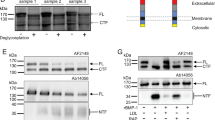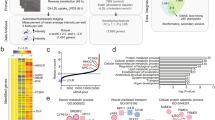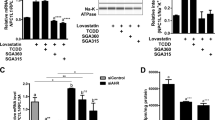Abstract
The risk of atherosclerosis, a leading cause of cardiovascular disease and death, is inversely related to plasma levels of high-density lipoprotein (HDL) cholesterol, although the mechanism of this protective effect is unclear1. The class B scavenger receptor, SR-BI, is the first HDL receptor to be well defined at a molecular level and is a mediator of selective cholesterol uptake in vitro2. It is expressed most abundantly in steroidogenic tissues, where it is coordinately regulated with steroidogenesis by adrenocorticotropic hormone (ACTH), human chorionic gonadotropin (hCG) and oestrogen, and in the liver, where its expression in rats is suppressed by oestrogen3,4. Here we show that adenovirus-mediated, hepatic overexpression of SR-BI in mice on both sinusoidal and canalicular surfaces of hepatocytes results in the virtual disappearance of plasma HDL and a substantial increase in biliary cholesterol. SR-BI may directly mediate these effects by increasing hepatic HDL cholesterol uptake or by increasing cholesterol secretion into bile, or both. These results indicate that SR-BI may be important in hepatic HDL metabolism, in determining plasma HDL concentrations, and in controlling cholesterol concentrations in bile, and thus may influence the development and progression of atherosclerosis and gallstone disease.
This is a preview of subscription content, access via your institution
Access options
Subscribe to this journal
Receive 51 print issues and online access
$199.00 per year
only $3.90 per issue
Buy this article
- Purchase on Springer Link
- Instant access to full article PDF
Prices may be subject to local taxes which are calculated during checkout
Similar content being viewed by others
References
Gordon, D. J. & Rifkind, B. M. High-density lipoprotein: the clinical implications of recent studies. N. Engl. J. Med. 321, 1311–1316 (1989).
Acton, S. et al. Identification of scavenger receptor SR-BI as a high density lipoprotein receptor. Science 271, 518–520 (1996).
Landschulz, K. T., Pathak, R. K., Rigotti, A., Krieger, M. & Hobbs, H. H. Regulation of scavenger receptor, class B, type I, a high density lipoprotein receptor, in liver and steroidogenic tissues of the rat. J. Clin. Invest. 98, 984–995 (1996).
Rigotti, A. et al. Regulation by adrenocorticotropic hormone of the in vivo expression of scavenger receptor class B type I (SR-BI), a high density lipoprotein receptor, in steroidogenic cells of the murine adrenal gland. J. Biol. Chem. 271, 33545–33549 (1996).
Kozarsky, K. F. et al. In vivo correction of low density lipoprotein receptor deficiency in the Watanabe heritable hyperlipidemic rabbit with recombinant adenoviruses. J. Biol. Chem. 269, 13695–13702 (1994).
Engelhardt, J. F et al. Direct gene transfer of human CFTR into human bronchial epithelia of xenografts with El-deleted adenoviruses. Nature Genet. 4, 27–34 (1993).
Herz, J. & Gerard, R. D. Adenovirus-mediated transfer of low density lipoprotein receptor gene acutely accelerates cholesterol clearance in normal mice. Proc. Natl Acad. Sri. USA 90, 2812–2816 (1993).
Yokode, M. R., Hammer, R. E., Ishibashi, S., Brown, M. S. & Goldstein, L. Diet-induced hypercholesterolemia in mice: prevention by overexpression of LDL receptors. Science 250, 1273–1275 (1990).
Willnow, T. E., Sheng, Z., Ishibashi, S. & Herz, J. Inhibition of hepatic chylomicron remnant uptake by gene transfer of a receptor antagonist. Science 264, 1471–1474 (1994).
Ishibashi, S., Brown, M. S., Goldstein, J. L., Gerard, R. D., Hammer, R. E. & Herz, J. Hypercholesterolemia in low density lipoprotein receptor knockout mice and its reversal by adenovirus-mediated gene delivery. J. Clin. Invest. 92, 883–893 (1993).
Glass, C., Pittman, R. C., Weistein, D. B. & Steinberg, D. Dissociation of tissue uptake of cholesterol ester from that of apoprotein A-I of rat plasma high density lipoprotein: selective delivery of cholesterol ester to liver, adrenal, and gonad. Proc. Natl Acad. Sci. USA 80, 5435–5439 (1983).
Brown, M. S. & Goldstein, J. L. A receptor-mediated pathway for cholesterol homeostasis. Science 232, 34–47 (1986).
Pittman, R. C., Knecht, T. P., Rosenbaum, M. S. & Taylor, C. A. A nonendocytotic mechanism for the selective uptake of high density lipoprotein-associated cholesterol esters. J. Biol. Chem. 262, 2443–2450 (1987).
Leitersdorf, E., Stein, O., Eisenberg, S. & Stein, Y. Uptake of rat plasma HDL subfractions labeled with [3H]cholesteryl linoleyl ether or with 125I by cultured rat hepatocytes and adrenal cells. Biochim. Biophys. Acta 796, 72–82 (1984).
Gwynne, J. T. & Mahafee, D. D. Rat adrenal uptake and metabolism of high density lipoprotein cholesteryl esters. J. Biol. Chem. 264, 8141–8150 (1989).
Reaven, E., Chen, Y.-D. I., Spicher, M. & Azhar, S. Morphological evidence that high density lipoproteins are not internalized by steroid-producing cells during in situ organ perfusion. J. Clin. Invest. 74, 1384–1397 (1984).
Rinninger, F. et al. Selective uptake of high-density lipoprotein-associated cholesteryl esters by human hepatocytes in primary culture. Hepatology 19, 1100–1114 (1994).
Botham, K. M. & Bravo, E. The role of lipoprotein cholesterol in biliary steroid secretion: studies with in vivo experimental models. Prog. Lipid Res. 34, 71–97 (1995).
Turley, S. & Dietschy, J. M. in The Liver, Biology and Pathobiology (eds Arias, I. M., Jakoby, W. B., Popper, H., Schachter, D. & Schafritz, D. A.) 617–641 (Raven, New York, 1988).
Rigotti, A., Marzolo, M. P. & Nervi, F. in Current Topics in Membranes (ed. Hoekstra, D.) 579–615 (Academic, San Diego, 1994).
Rigotti, A., Marzolo, M. P., Ulloa, N. & Nervi, F. Effect of bean intake on biliary lipid secretion and on hepatic cholesterol metabolism in the rat. J. Lipid Res. 30, 1041–1048 (1989).
Carey, M. C. in Bile Acids, Cholestasis and Gallstones (eds H. Fromm, H. & Leuschner, U.) 147–175 (Kluwer, Dordrecht, 1996).
Thornton, J. R., Heaton, K. W. & MacFarlane, D. G. A relation between high-density-lipoprotein cholesterol and bile cholesterol saturation. Br. Med. J. 283, 1352–1354 (1981).
Del Pozo, R., Nervi, F., Covarrubias, C. & Ronco, B. Reversal of progesterone-induced biliary cholesterol output by dietary cholesterol and ethynylestradiol. Biochim. Biophys. Acta 753, 164–172 (1983).
Sewell, R. B., Mao, S. J., Kawamoto, T. & LaRusso, N. F. Apolipoproteins of high, low, and very low density lipoproteins in human bile. J. Lipid Res. 24, 391–401 (1983).
Domingo, N. et al. Epitope mapping of the human biliary amphipathic, anionic polypeptide: similarity with a calcium-binding protein isolated from gallstones and bile, and immunologic cross-reactivity with apolipoprotein A-I. J. Lipid Res. 33, 1419–1430 (1992).
Ye, X. et al. Prolonged metabolic correction in adult ornithine transcarbamylase-deficient mice with adenoviral vectors. J. Biol. Chem. 271, 3639–3646 (1996).
Kozarsky, K. F., Jooss, K., Donahee, M., Strauss, J. F. & Wilson, J. M. Effective treatment of familial hypercholesterolaemia in the mouse model using adenovirus-mediated transfer of the VLDL receptor gene. Nature Genet. 13, 54–62 (1996).
Kozarsky, K., Grossman, M. & Wilson, J. M. Adenovirus-mediated correction of the genetic defect in hepatocytes from patients with familial hypercholesterolemia. Somat. Cell Mol. Genet. 19, 449–458 (1993).
Ulloa, N., Garrido, J. & Nervi, F. Ultracentrifugal isolation of vesicular carriers of biliary cholesterol in native human and rat bile. Hepatology 7, 234–244 (1987).
Author information
Authors and Affiliations
Rights and permissions
About this article
Cite this article
Kozarsky, K., Donahee, M., Rigotti, A. et al. Overexpression of the HDL receptor SR-BI alters plasma HDL and bile cholesterol levels. Nature 387, 414–417 (1997). https://doi.org/10.1038/387414a0
Received:
Accepted:
Issue Date:
DOI: https://doi.org/10.1038/387414a0
This article is cited by
-
Short-term effects of allulose consumption on glucose homeostasis, metabolic parameters, incretin levels, and inflammatory markers in patients with type 2 diabetes: a double-blind, randomized, controlled crossover clinical trial
European Journal of Nutrition (2023)
-
Hepatocyte ATF3 protects against atherosclerosis by regulating HDL and bile acid metabolism
Nature Metabolism (2021)
-
Potential osteomyelitis biomarkers identified by plasma metabolome analysis in mice
Scientific Reports (2020)
-
Novel interactomics approach identifies ABCA1 as direct target of evodiamine, which increases macrophage cholesterol efflux
Scientific Reports (2018)
-
HDL Cholesterol Metabolism and the Risk of CHD: New Insights from Human Genetics
Current Cardiology Reports (2017)
Comments
By submitting a comment you agree to abide by our Terms and Community Guidelines. If you find something abusive or that does not comply with our terms or guidelines please flag it as inappropriate.



